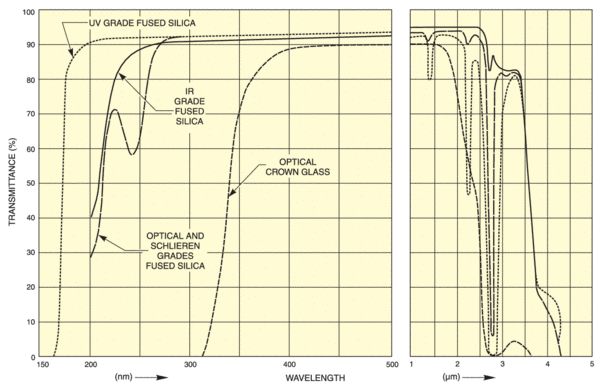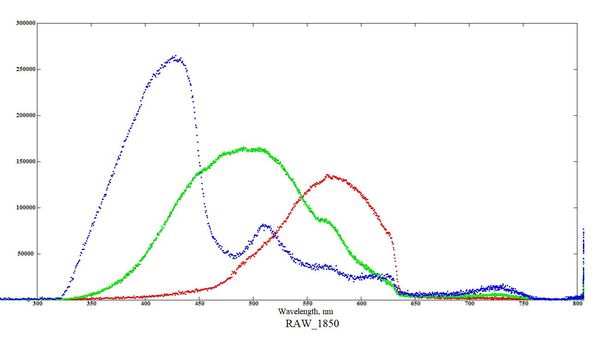Bayer filter spectral response measurement
Aug 27, 2020 14:13:21 #
Stuck at home project. Decided to measure the spectral response of the various color filters in the Bayer array. Description is in the PDF file attached.
Aug 27, 2020 14:27:13 #
Interesting project. So is that a lot of response in the ultraviolet range. I thought digital cameras didn't need uv filters any more?
Aug 27, 2020 15:56:05 #
DirtFarmer wrote:
Stuck at home project. Decided to measure the spectral response of the various color filters in the Bayer array. Description is in the PDF file attached.
What are the units on the vertical scale?
Aug 27, 2020 15:58:57 #
bleirer wrote:
Interesting project. So is that a lot of response in the ultraviolet range. I thought digital cameras didn't need uv filters any more?
I have heard that as well*. Is that supposedly due to the filter response or due to the the response of the sensor?
*I have also see what appears to be a blue cast in daylight shots in digital images so perhaps there is some effect but it’s less than with film.
Aug 27, 2020 16:03:09 #
JD750 wrote:
What are the units on the vertical scale?
That is the number from the tiff file at each pixel. The numbers are large because several pixels are added together to reduce noise.
Aug 27, 2020 21:11:58 #
DirtFarmer wrote:
That is the number from the tiff file at each pixel. The numbers are large because several pixels are added together to reduce noise.
Interesting. Thanks for posting that.
So how did you go about getting that? How did you set that up? What Light source did you use?
Aug 28, 2020 07:40:49 #
JD750 wrote:
Interesting. Thanks for posting that.
So how did you go about getting that? How did you set that up? What Light source did you use?
So how did you go about getting that? How did you set that up? What Light source did you use?
The writeup is in the first attachment, a PDF file (5 pages).
Looks like it got kind of mixed up with the example plot (second attachment).
Click on the "(Download)" just above the word "Example".
Note that the red end is cut off by vignetting in the spectrometer. It should go further out.
Aug 28, 2020 09:18:07 #
I have been experimenting with UV and IR. Cameras, at least Canon see more UV than books lead me to believe, but probably not enough for short shutter speeds under many conditions. Also filters used to cut out the visible and IR would reduce it still more. Sharp drop in IR is due to the hot mirror. This is way astro versions, 20Da, 60Da, new Ra use a different filter to let in more light at just above the cutoff, H-alpha wavelenght for nebula, especially.
Aug 28, 2020 09:57:23 #
bleirer wrote:
Interesting project. So is that a lot of response in the ultraviolet range. I thought digital cameras didn't need uv filters any more?
Film is very sensitive to UV, sensors not so much. Even if you have a camera modified to shoot full spectrum it’s very limited to use as a UV camera because most lenses block a lot of the UV spectrum. You need special glass
Aug 28, 2020 13:47:46 #
SuperflyTNT wrote:
Film is very sensitive to UV, sensors not so much. Even if you have a camera modified to shoot full spectrum it’s very limited to use as a UV camera because most lenses block a lot of the UV spectrum. You need special glass
That's why I asked, he does shoot through a lens for this test, but both blue and green photosites show activity in the 325 to 400 range, which is clearly UV, no? Blue especially has a lot relative to its peak.
Aug 28, 2020 13:53:28 #
SuperflyTNT wrote:
Film is very sensitive to UV, sensors not so much. Even if you have a camera modified to shoot full spectrum it’s very limited to use as a UV camera because most lenses block a lot of the UV spectrum. You need special glass
Most modern films are not very sensitive to UV at all. Only a few specialty films are.
Aug 28, 2020 14:37:42 #
bleirer wrote:
That's why I asked, he does shoot through a lens for this test, but both blue and green photosites show activity in the 325 to 400 range, which is clearly UV, no? Blue especially has a lot relative to its peak.
Of course I had to use a lens to image the spectrum. The lens was a Nikkor 24-70 f/2.8 in some of the tests and a Nikkor 105 f/2.8 Micro for others. I do not know what kind of glass is used in those lenses (probably several different kinds) but the UV cutoff for glass is a function of the material. And naturally the UV absorption is a function of thickness.
Maybe we should be looking at the transmission profile of UV filters to find out where they cut off?
https://www.newport.com/n/optical-materials

Aug 28, 2020 14:57:49 #
DirtFarmer wrote:
Of course I had to use a lens to image the spectru... (show quote)
The data chart here shows very little making it through for most cameras, maybe 3-5%, the graph is a little hard to read. What percent would show up as haze at high altitude?
https://petapixel.com/2020/06/04/why-uv-filters-are-basically-useless-on-modern-cameras/
Aug 28, 2020 15:50:53 #
The modern coatings on lens is more of a problem than the glass from 350 to 400. Older lens work better. Yes the glass is a problem, more glass in the lens the worse it gets, but the coatings are also a real killer. Lens made for UV use silica and CaF elements and cost more than $5000 for a relatively simple non-UV version ($200 to 500). Nikon made an older one, but it sells used for $7000 I believe. There is a small UV only camera which attaches to a cell phone, which does well for flowers in natural light. They also cell a UV light for it, but I used it for flowers with just sunlight. Exact number of pixels, etc. I do not know. Replacing the hot mirror with a silica one allows UV and IR use (full spectrum), but filters needed. It should be noted that many UV filters also leak IR, so more than one filter may be needed.
Aug 28, 2020 16:25:42 #
JD, I don't wish to sidetrack this thread. Your * remark borders on Color Contamination in images. A thread I'm working at posting sometime in the near future.
--Bob
--Bob
JD750 wrote:
I have heard that as well*. Is that supposedly due to the filter response or due to the the response of the sensor?
*I have also see what appears to be a blue cast in daylight shots in digital images so perhaps there is some effect but it’s less than with film.
*I have also see what appears to be a blue cast in daylight shots in digital images so perhaps there is some effect but it’s less than with film.
If you want to reply, then register here. Registration is free and your account is created instantly, so you can post right away.



